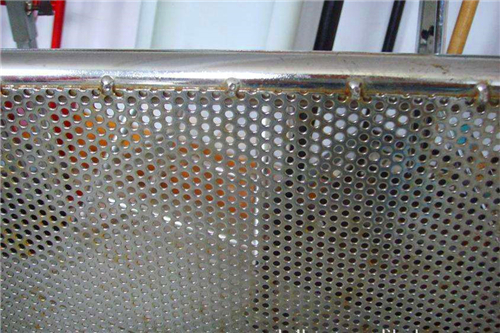Key Factors Affecting the Service Life of Metal Perforated Sheets
Source:www.cn-psp.cnAuthor:河北森驰公司 Last updated:2025-04-17 10:08:21 Browse:
This article provides a comprehensive analysis of the multiple factors that influence the service life of metal perforated sheets, including sheet thickness, material selection, surface‑treatment processes, environmental conditions, installation quality, and routine maintenance, helping you scientifically extend the lifespan of your perforated panels.
1. Impact of Sheet Thickness on Service Life
Greater thickness, longer life: Thicker perforated sheets offer superior compressive, bending and wear resistance, effectively withstanding external impacts and friction, thereby extending the service life of perforated sheets.
Thin sheets prone to deformation: In high‑intensity operations, wind loads or frequent friction environments, thin sheets can develop plastic deformation or cracking, accelerating their lifespan decline.
2. Material Selection and Corrosion Resistance
Advantages: Exceptional corrosion resistance, strong oxidation resistance and high strength, ideal for coastal, chemical and food‑processing environments.
Service life: Often several times longer than ordinary carbon steel.
Advantages: Low cost, good workability.
Drawbacks: Prone to rust; without regular anti‑rust treatment, its service life is significantly shortened.
Advantages: Lightweight, excellent corrosion resistance.
Applications: Interior décor, signage, ventilation and cooling panels.
3. Protective Role of Surface Treatment Processes
Hot‑dip galvanizing: Forms a thick zinc layer on the sheet’s surface, offering the strongest corrosion resistance and a service life exceeding 15 years.
Powder coating & fluorocarbon spraying: Isolate corrosive agents via a protective layer; suitable for general outdoor and indoor environments.
Electro‑galvanizing & painting: Lower cost but thinner coatings that can peel under heat, humidity or chemical exposure, requiring frequent maintenance.

4. Environmental Factors Limiting Service Life
Marine or High‑Humidity Environments
High humidity and salt content accelerate metal corrosion; choose stainless steel or hot‑dip galvanized sheets and reinforce surface protection.
Industrial or Chemical‑Corrosive Environments
Exposure to volatile acids, alkalis and organic solvents demands high‑grade anti‑corrosion treatments.
Dry and Mild Inland Regions
Corrosion progresses more slowly; surface‑treatment demands can be moderated, though basic protection remains essential.
5. Installation and Construction Quality
Proper fastening methods: Prevent stress concentration, collisions or abrasion around perforation edges.
Expansion gaps: Allow for thermal expansion and contraction to reduce cracking risk.
Precision cutting & punching: Laser or punch‑press cuts must yield smooth edges without oxide scale or burrs.
6. Routine Maintenance and Care Recommendations
Regular cleaning: Remove dust and acidic or alkaline residues promptly to prevent localized corrosion.
Coating inspections: Repair cracks or peeling with touch‑up paint or re‑galvanizing.
Spot repairs: Sand and remove rust spots, then apply rust‑inhibitive primer.
Environmental monitoring: In coastal or chemical facilities, install online humidity and chloride‑ion sensors for early warnings.
7. Additional Influencing Factors
Chemical pH: In strongly acidic or alkaline settings, select materials or coatings rated for high‑corrosion resistance.
UV exposure & high temperatures: Prolonged UV radiation can age and embrittle coatings, reducing protection.
Vibration & impact: In continuously vibrating environments, reinforce support structures to prevent fatigue failure.
Conclusion
The service life of metal perforated sheets results from the combined effects of numerous factors. By choosing the right sheet thickness, high‑quality materials, sound surface‑treatment processes, and considering actual environmental conditions—while ensuring proper installation and diligent maintenance—you can maximize perforated‑sheet durability and minimize long‑term upkeep costs.
Left panel showcases our recommended metal perforated sheet products. Contact us for inquiries and orders!
